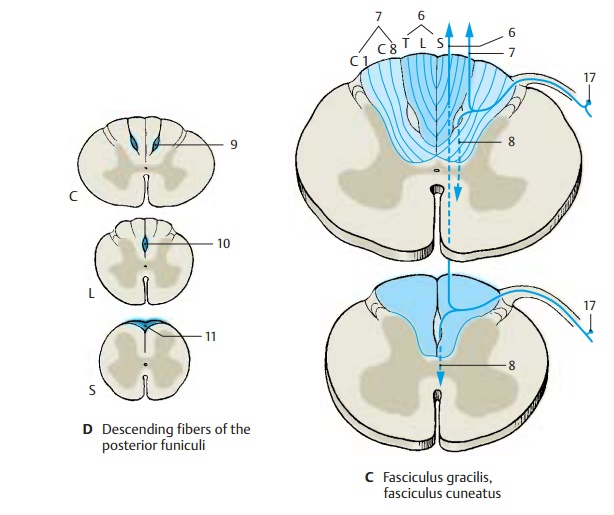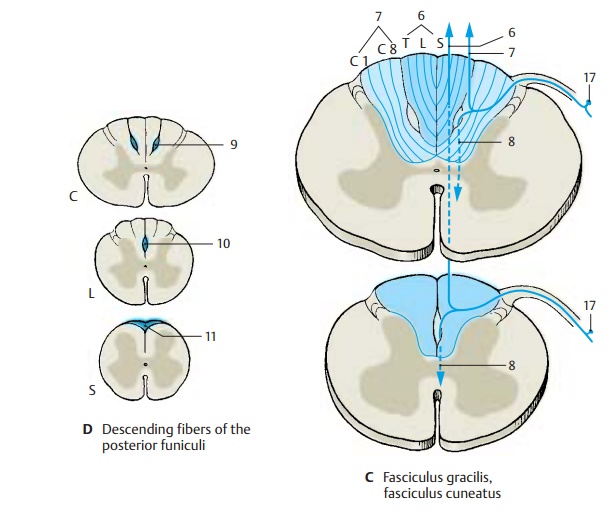Chapter: Human Nervous System and Sensory Organs : Spinal Cord and Spinal Nerves
Ascending Pathways - Spinal Cord

Ascending Pathways
Tracts of the Anterolateral Funiculus (A)
Lateral spinothalamic tract (A1). The affer-ent, poorly myelinated posterior root fibers (A2) (first neuron of sensory pathway) bi-furcate in theposterolateral tract (Lissauer’s tract) and terminate at the cells of the gelat-inous substance of the posterior horn. Thefibers of the tract originate here, cross in the white commissure to the opposite side, andascend in the lateral funiculus to the thalamus (second neuron). The pathway transmits pain and temperature sensation, exteroceptive and proprioceptive impulses. Itis somatotopically subdivided; sacral (S) and lumbar (L) fibers are located dorsolater-ally, while thoracic (T) and cervical (C) fibers are located ventromedially. Fibers for pain sensation probably lie superficially, while those for temperature sensation lie more deeply.

Anterior spinothalamic tract (A3).The af-ferent fibers (A4) (first neuron) bifurcate into ascending and descending branches and terminate at posterior horn cells, the fibers of which cross to the opposite side and ascend in the anterior funiculus to the thalamus (second neuron). They transmitcrude touch and pressure sensations. To-gether with the lateral tract, they form the pathway of protopathic sensibility.
The spinotectal tract (A5) carries pain fibers to the roof of the midbrain (contrac-tion of pupils when in pain).
Pathways of the Posterior Funiculus (C, D)
Fasciculus gracilis (of Goll) (C6) and fasciculus cuneatus (of Burdach) (C7). Thethick heavily myelinated fibers ascend without relay in the ipsilateral posterior funiculi. They belong to the first neuron of the sensory pathway and terminate at the nerve cells of the posterior funiculus nuclei (second neuron). They trans-mit exteroceptive and proprioceptive im-pulses of the epicritic sensibility (exterocep-tive, information on localization and qualityof tactile sensation; proprioceptive, infor-mation on limb position and body posture). The posterior funiculi are somatotopically subdivided; the sacral fibers lie medially, followed laterally by the lumbar and thoracic fibers (fasciculus gracilis). The fibers from T3 to C2 lie laterally and form the fasciculus cuneatus.
Short ascending collaterals (C8) branch from the ascending fibers. They terminate at the posterior horn cells and form compact bundles, namely, thecomma tract ofSchultze (D9) in the cervical spinal cord, Flechsig’s oval field (D10) in the thoracic spi-nal cord, and the Phillippe – Gombault tri-angle(D11) in the sacral spinal cord.

Cerebellar Pathways of the Lateral Funiculus (B)
Posterior spinocerebellar tract (Flechsig’s tract) (B12).The afferent posterior hornfibers (first neuron) terminate at the cells of the dorsal nucleus of Clarke (B13) from where the tract (second neuron) originates. It runs along the margin of the ipsilateral lateral funiculus to the cerebellum and transmits mainly proprioceptive impulses (from joints, tendons, muscle spindles).
Anterior spinocerebellar tract (Gowers’ tract) (B14).The cells of origin lie in the pos-terior horn. Their fibers (second neuron) as-cend ipsilaterally as well as contralaterally along the anterolateral margin of the spinal cord to the cerebellum, to which they trans-mit exteroceptive and proprioceptive im-pulses. Both cerebellar pathways are soma-totopically subdivided; the sacral fibers lie dorsally, the lumbar and thoracic fibers ven-trally.
The spino-olivary tract (B15) and vesti-bulospinal tract (B16) arise from the poste-rior horn cells of the cervical spinal cord; they transmit mainlyproprioceptive im-pulses to the inferior olive of the oppositeside and to the vestibular nuclei.
A – C17 Neurons in the spinal ganglion (firstneuron).
Related Topics